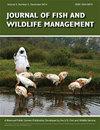Assessment of Potential Recovery Viability for Colorado Pikeminnow Ptychocheilus lucius in the Colorado River in Grand Canyon
IF 0.9
4区 环境科学与生态学
Q4 BIODIVERSITY CONSERVATION
引用次数: 0
Abstract
Colorado Pikeminnow Ptychocheilus lucius, the Colorado River’s top native predatory fish, was historically distributed from the Gulf of California delta to the upper reaches of the Green, Colorado, and San Juan rivers in the Colorado River basin in the Southwestern US. In recent decades Colorado Pikeminnow population abundance has declined, primarily due to predation by warmwater nonnative fish and habitat modification following dam construction. Small, reproducing populations remain in the Green and upper Colorado rivers, but their current population trajectory is declining and the San Juan River population is maintained primarily through stocking. As such, establishment of an additional population could aid recovery efforts and increase the species’ resilience and population redundancy. The Colorado River in Grand Canyon once supported Colorado Pikeminnow, but until recently habitat suitability in this altered reach was considered low due to a depressed thermal regime and abundant nonnative predators. Climate change and ongoing drought has presented an opportunity to evaluate the feasibility of native fish restoration in a system where declining reservoir storage has led to warmer releases and re-emergence of riverine habitat. These changes in the physical attributes of the river have occurred in concert with a system-wide decline in nonnative predators. Conditions ten years ago were not compatible with reintroduction feasibility in Grand Canyon; however, due to rapidly changing conditions an expert Science Panel was convened to evaluate whether the physical and biological attributes of this reach could now support various life stages of Colorado Pikeminnow. Here, we report on the evaluation process and outcome from the Science Panel, which developed a science-based recommendation to the U.S. Fish and Wildlife Service on reintroduction feasibility. The Science Panel concluded that current habitat attributes in Grand Canyon could satisfy some, but perhaps not all, Colorado Pikeminnow life history requirements. This reach has the potential to support adult and sub-adult growth, foraging, migrations, and spawning, but low juvenile survival may limit recruitment. However, populations of other native species are successfully reproducing and increasing in western Grand Canyon, even in areas once considered suboptimal habitat. Should managers decide to move to the next phase of this process, actions such as experimental stocking and monitoring, telemetry studies, bioenergetics modeling, and laboratory-based research may provide additional information to further evaluate a potential reintroduction effort in this rapidly changing but highly altered system.科罗拉多Pikeminow Ptychocheilus lucius在大峡谷科罗拉多河的潜在恢复可行性评估
科罗拉多Pikeminow Ptychocheilus lucius是科罗拉多河的顶级本土掠食性鱼类,历史上分布于美国西南部科罗拉多河流域的加利福尼亚湾三角洲至格林河、科罗拉多河和圣胡安河上游。近几十年来,科罗拉多Pikemingow种群数量有所下降,主要是由于暖水非本地鱼类的捕食和大坝建设后栖息地的改变。格林河和科罗拉多河上游仍有少量繁殖种群,但它们目前的种群轨迹正在下降,圣胡安河的种群主要通过放养来维持。因此,建立一个额外的种群可以帮助恢复工作,增加物种的恢复力和种群冗余。大峡谷中的科罗拉多河曾经支持科罗拉多Pikeminow,但直到最近,由于气候低迷和大量的非本土捕食者,这一变化河段的栖息地适宜性一直被认为很低。气候变化和持续的干旱为评估在一个水库蓄水量下降导致河流栖息地变暖和重新出现的系统中恢复本地鱼类的可行性提供了机会。河流物理特性的这些变化与全系统非本土捕食者的减少是一致的。十年前的条件与大峡谷的重新引入可行性不兼容;然而,由于条件的快速变化,一个专家科学小组被召集来评估这一地区的物理和生物特性现在是否可以支持科罗拉多Pikeminow的各个生命阶段。在这里,我们报告了科学小组的评估过程和结果,该小组就重新引入的可行性向美国鱼类和野生动物管理局提出了一项基于科学的建议。科学小组得出结论,大峡谷目前的栖息地特征可以满足科罗拉多州派克明诺生活史的一些要求,但可能不是全部。这一范围有可能支持成年和亚成年的生长、觅食、迁徙和产卵,但幼年存活率低可能会限制招募。然而,其他本土物种的种群在大峡谷西部成功繁殖并增加,即使在曾经被认为是次优栖息地的地区也是如此。如果管理者决定进入这一过程的下一阶段,实验储存和监测、遥测研究、生物能量学建模和实验室研究等行动可能会提供额外信息,以进一步评估在这个快速变化但高度变化的系统中可能的重新引入工作。
本文章由计算机程序翻译,如有差异,请以英文原文为准。
求助全文
约1分钟内获得全文
求助全文
来源期刊

Journal of Fish and Wildlife Management
BIODIVERSITY CONSERVATION-ECOLOGY
CiteScore
1.60
自引率
0.00%
发文量
43
审稿时长
>12 weeks
期刊介绍:
Journal of Fish and Wildlife Management encourages submission of original, high quality, English-language scientific papers on the practical application and integration of science to conservation and management of native North American fish, wildlife, plants and their habitats in the following categories: Articles, Notes, Surveys and Issues and Perspectives. Papers that do not relate directly to native North American fish, wildlife plants or their habitats may be considered if they highlight species that are closely related to, or conservation issues that are germane to, those in North America.
 求助内容:
求助内容: 应助结果提醒方式:
应助结果提醒方式:


